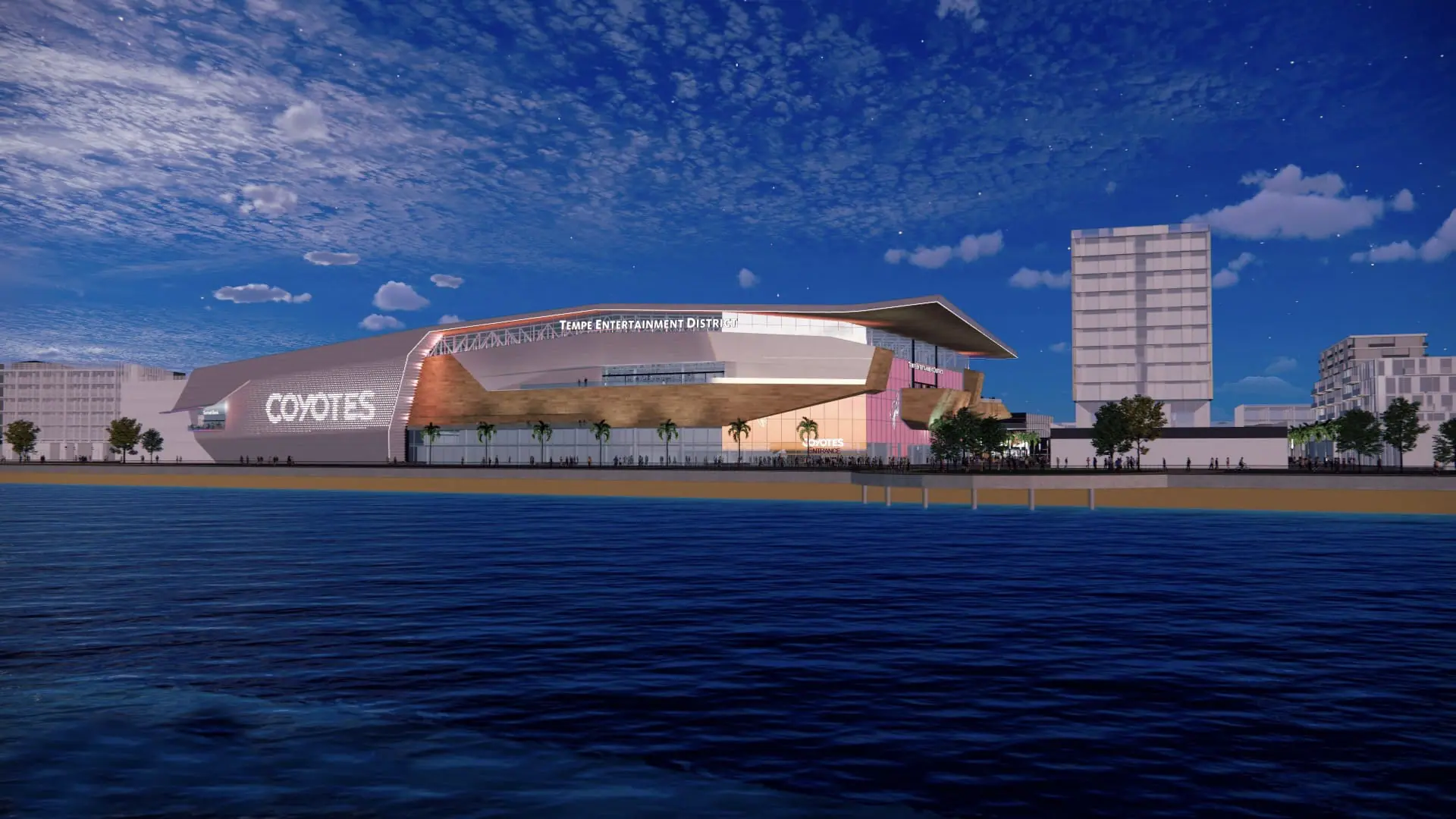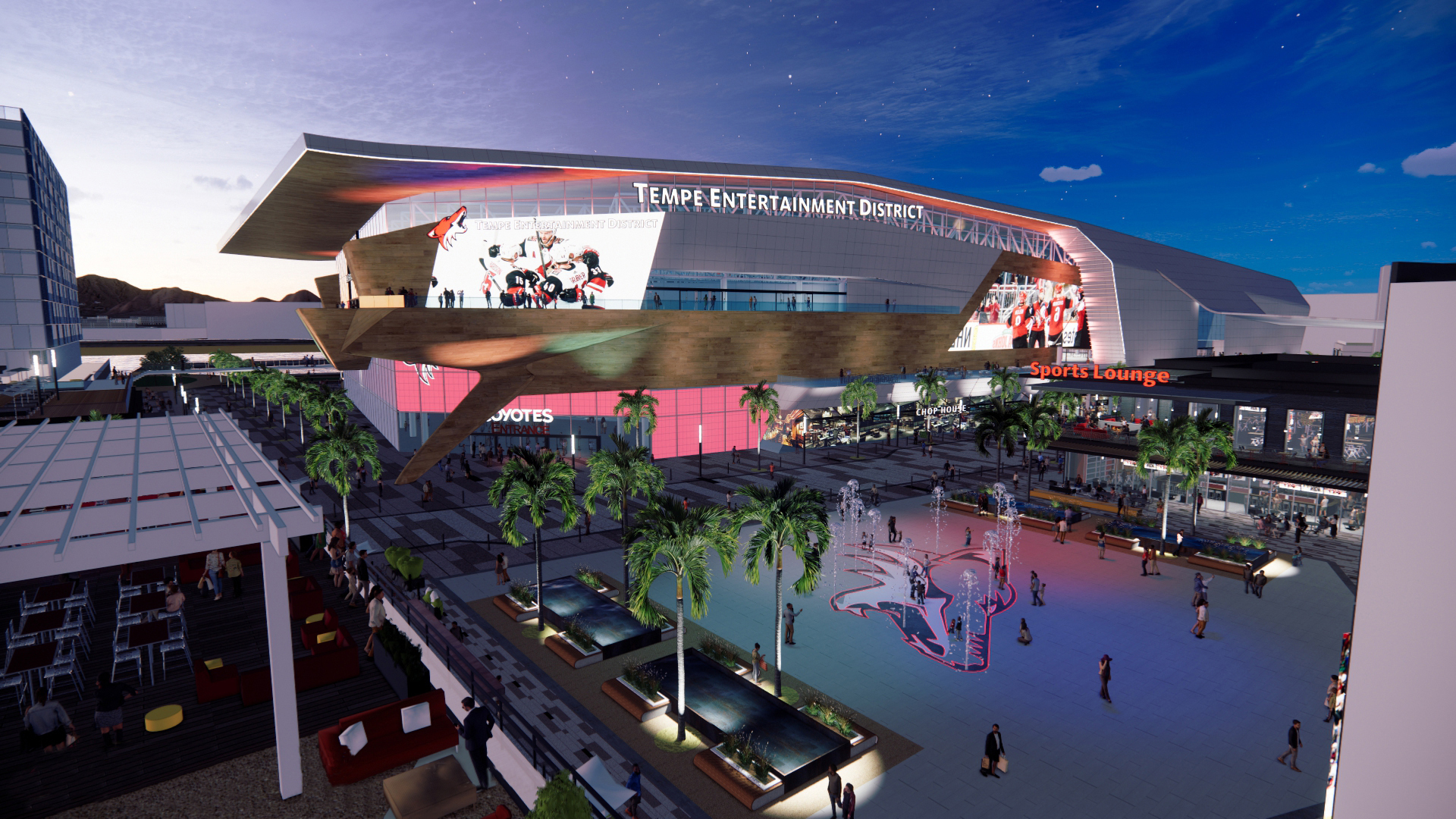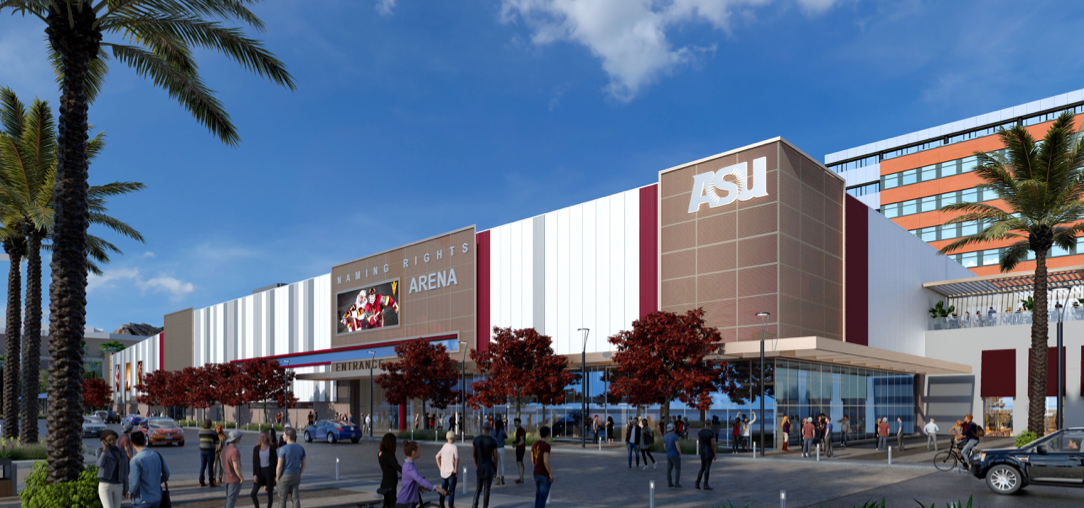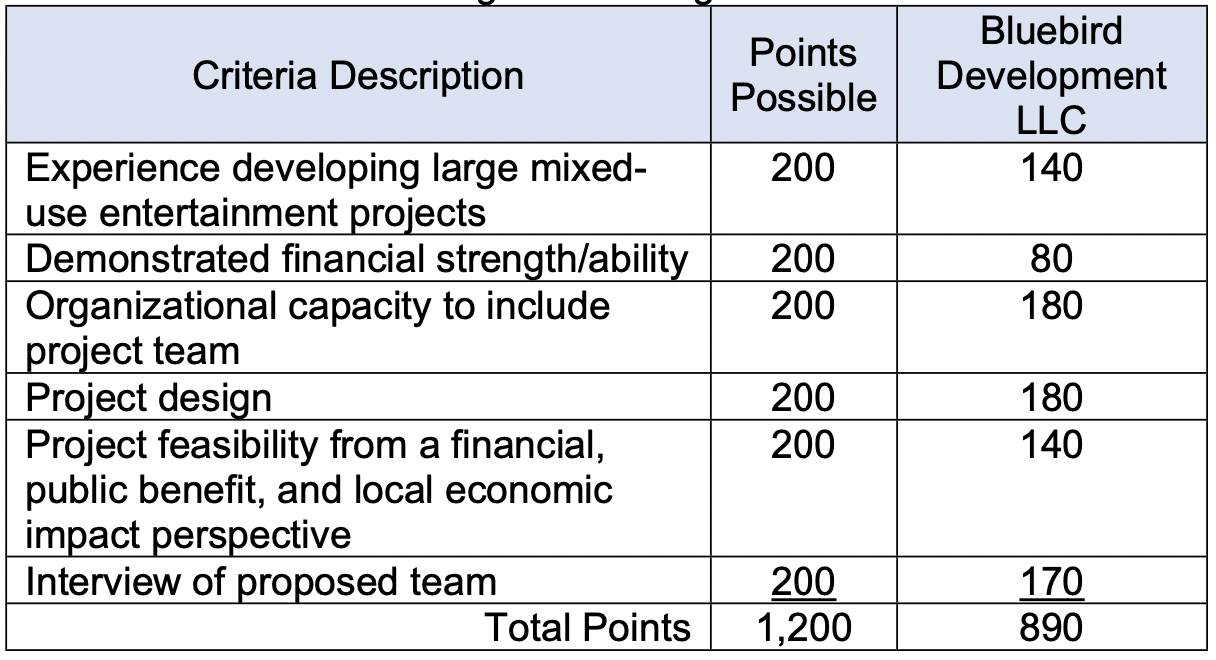© 2025 ALLCITY Network Inc.
All rights reserved.

Decision day has finally arrived for the Coyotes and the Tempe City Council. At least we think it has, given the fluid progression of this story since Tempe first issued a request for proposal (RFP) nearly 11 months ago for a sports and entertainment district to house a professional sports franchise at a 46-acre site along the south bank of the Salt River just east of Priest Drive.
This story has been fraught with twists, turns, delays, changes, animosity, bad actors and lots of misinformation. So if you have been following the Coyotes’ saga for the past 26 years, it’s business as usual.
The Coyotes were the only entity that responded to that RFP (hint: Tempe wanted the Coyotes) and the Tempe City Council is expected to discuss the franchise’s proposed arena and entertainment district in a special council meeting at 2 p.m. on Thursday.
A yes decision from the council would mean that the city and the developer can negotiate further with the goal of striking a deal. It would not signal an approval of the project itself. It would simply trigger a months-long process that would also include community input and public meetings.
A no decision would mean that the council has officially declined the proposal of the developer, at which point the council could choose to issue a new call for proposals at this location.
Which way is the council leaning? As of late Wednesday night, it appeared that the council was prepared to award the RFP to the Coyotes and move forward with negotiations. Sources told PHNX Sports on Wednesday night that there were at least four yes votes, perhaps more.
Both the team and the city have sought feedback from residents and fans so there could be a multitude of speakers at Thursday’s meeting before the council actually votes on the proposal. It could be a long day before the vote comes.
Given all of the information that has circulated regarding this proposal, here is a primer on everything that you need to know before this critically important meeting.

The proposal
The Coyotes have proposed a $1.7-billion development that includes a hockey arena, hotels, apartments, retail stores and a sports book. The team says that the project would be privately financed, although it hopes to use a portion of city sales tax revenue generated by the development to help pay for $200 million in additional costs.
The Coyotes would need to remove an estimated 1.5 million tons of trash from the site, which is currently a city dump. The team would then need to remediate the site before construction begins at a cost of approximately $70 million. The team would pay $40 million for the east parcel cleanup and commit $8 million toward remediation of the west parcel, with the remaining costs paid through bonds. The bonds would also pay for such infrastructure as electric lines, water lines, sewer lines, roads and a parking garage at the northeast corner of the property that would be owned and operated by the city
The team says that the project could generate $154 million in new taxes for the city over a 30-year period, with $5.9 billion in direct spending in the city and 6,900 permanent jobs created.
Multiple media outlets viewed the proposal last fall, but the team recently released a slick presentation that outlined key points of the proposal that you can view here.

The need
By now, everyone knows that the Coyotes’ lease at Gila River Arena in Glendale expires on June 30. The City of Glendale sought to sign the Coyotes to a long-term lease agreement. When the team refused anything more than a short-term lease, and when it became clear that the Coyotes were pursuing an arena deal in Tempe, the city elected to move on.
The move caught the Coyotes by surprise. They expected Glendale to relent and agree to a short-term lease despite the team’s and NHL commissioner Gary Bettman’s long-stated goal of finding an arena solution in a location more conducive to financial success. They figured that Glendale needed the event dates and the associated money too badly.
When it became clear that Glendale’s stance was firm, the Coyotes pursued other temporary options including playing games at Chase Field, Arizona Veterans Memorial Coliseum and Arizona State’s new, 5,000-seat, multi-purpose arena. In the end, the team decided that the ASU option made the most sense, both because it was new and because it allowed the Coyotes to begin forging partnerships with Tempe and ASU.
The deal with ASU calls for the Coyotes to play all of their home games at the multi-purpose arena for the next three seasons with an option for a fourth season. The team has already begun construction on an annex at the northeast corner of the arena that will house all of the Coyotes’ team areas. The team will pay approximately $20 million for that annex, as well as about $5 million in upgrades within the arena that are necessary to bring it up to NHL standards. When the team’s lease expires, ASU gets to keep all of the upgrades at no cost to the university.

The hurdles
There are multiple parties that do not want to see this deal consummated, including some Tempe residents, the City of Phoenix, the City of Glendale and Sky Harbor International Airport officials. Let’s discuss those, one by one.
Residents: Some local residents have been vocal and organized in their opposition to the project, which is often the case for so-called NIMBYs (not in my backyard). If anybody deserves a voice in this project, it is those who are most impacted by its proximity. There will be noise. There will be traffic. There will be some unruly behavior, but it is also somewhat perplexing to hear those who settled in an urban area now balking at the idea of their neighborhood becoming, well, urban. The City of Tempe sits adjacent to Phoenix. Try and find a metropolitan area in the U.S. where a suburb adjacent to a major metropolitan area does not also foster this sort of development. It’s naive of residents to think that they can just preserve the status quo or create more recreational space along the river. An extension of a parkway along Rio Salado produces nothing financially for the city and this real estate is ripe for development. Multiple Tempe sources believe that this deal is fantastic for the city. Follow the money.
The City of Phoenix: This one is more complex because the City of Phoenix’s influence isn’t always out in the open. Do not doubt for a second, however, that when airport officials’ lips move, or when former Phoenix mayors write editorials in the local paper, the City of Phoenix is the ventriloquist’s hand moving the puppets. The city is working hard to kill this deal because it would hurt the city financially. A shiny new arena would create competition for shows with Footprint Center (and Suns owner Robert Sarver) in downtown Phoenix. A new entertainment district would also create competition for the city; competition that sits in the middle of nightlife-friendly ASU and just five miles from popular Old Town Scottsdale.
But here’s another thought to ponder: Does Phoenix want the Coyotes for itself? A government source told PHNX that two Phoenix council members are interested in wooing the Coyotes back to the city, where they played from 1996-2003. That is theoretically possible if Phoenix successfully blocks Tempe’s efforts.
The City of Glendale: Speaking of competition, no city stands to lose more from a Tempe arena than Glendale, the city that saved the Coyotes from relocation back in the early part of this millennium. City manager Kevin Phelps has painted a rosy picture of Gila River Arena’s future, comparing its potential to The Forum in Los Angeles. Let’s be clear here. Greater metropolitan LA has a population of about 18.7 million and three arenas of the approximate size in question (Crypto.com Arena, The Forum, and 12,829-seat Pauley Pavilion). Greater metropolitan Phoenix has a population of about 5 million. The Valley will have a much harder time supporting three arenas and Gila River Arena will always be the third option, given its location. The city still owed $139 million for Gila River Arena in 2019, before the pandemic hit. It borrowed $180 million to build it in 2003.
CASE: CASE and its parent company Unite Here (a hospitality union) are whipping up opposition to push their agenda, which is to unionize the hotel and food-service pieces of the development. CASE executive director Brendan Walsh has been active behind the scenes.
The airport: Where to begin? The airport (and its Phoenix master) has been a thorn in Tempe’s side for decades. Longtime Valley residents will recall the same ploys at play when the Cardinals tried to build their stadium along the Salt River before giving up the fight and moving west to Glendale.
Neil Giuliano and Hugh Hallman were Tempe’s mayors in that time span and both had an up-close look at the City of Phoenix’s game plan. I began corresponding with Hallman in January and he told me that our conversations inspired him to write this scathing editorial, which appeared in the Phoenix Business Journal.
Aviation officials have raised a number of issues with the proposed development, suggesting that it would create safety and noise hazards. Deputy aviation director Jordan Feld, has estimated that the airport could absorb a $264 million economic hit during the project’s construction.
At an aviation board meeting in late May, Coyotes president and CEO Xavier Gutierrez, attorney Nick Wood and other officials were on hand to counter those claims. Gutierrez told the board that the economic analysis exaggerated the height of buildings and construction cranes that would be used. While the analysis determined that the Coyotes would have six cranes piercing the One Engine Inoperative (OEI) surface (a term used for emergency situations in which an airplane experiences engine failure and must turn around and return to the airport), the Coyotes’ presentation made it clear that only one crane (the arena crane) would pierce that surface by 16 feet on one side and 26 on the other, and that would only occur for 21 days of construction.
The Coyotes also noted that aviation officials did not seem concerned when other cranes used to build nearby Carvana, the IDEA Tempe Campus and the airport’s own sky train and rental car facility pierced that surface for much longer, and at much greater heights.
After that meeting, the airport posted an update on its website, lauding the developers’ commitment to addressing height-safety concerns, but that same update suggested that the Coyotes had not addressed the “most important obstacle”: incompatible land use for residential units so close to the airport. Airport officials contend that the proposed residential units are in breach of a 1994 Intergovernmental Agreement between Phoenix and Tempe. Here is the letter sent by attorney Jean-Jacques Cabou to Tempe city attorney Sonia Blain.
The Coyotes counter? The letter is an empty threat and there is zero basis for the claim. There are more than 3,600 residential units constructed along Tempe Town Lake and located within the 65-decibel noise contour; more than 1,500 similar units in Phoenix. They were all permitted because the regulations permit such development so long as there are noise attenuation elements installed in the structure of the buildings that reduce internal noise, as well as avigation easements in favor of the airport, and disclosure provisions in all leases and contracts and covenants not to sue.
Per sources, city council and staff members do not appear to view the issues that the airport has raised as significant concerns, with many viewing them in the same light as Hallman. They may face a fight, however.
For what it’s worth, both Hallman and Giuliano support the development. Former Tempe Mayor Mark Mitchell has not weighed in publicly on the development.

The financial aspect
While the airport squabble has drawn steady attention, the city’s evaluation team, working with consultants, released its recommendation to the council on Friday to move forward with the RFP. At the same time, it also released a six-point evaluation of the developer. In that evaluation, it gave owner Alex Meruelo and his group just 80 out of a possible 200 points for demonstrated financial strength and ability.

It’s no secret that Meruelo’s businesses suffered during the global pandemic. His two casinos, the Grand Sierra Resort in Reno, Nevada and the Sahara Las Vegas in Las Vegas, were hit hard, as were the Coyotes, who played to empty or partially full stadiums during COVID-induced crowd limits, and then drew small crowds during a dismal rebuilding year in 2021-22.
Opponents of the Tempe deal have seized on this latest information to raise further doubts about Meruelo’s ability to complete this deal, and the Coyotes did not help their cause with a string of unpaid taxes, late lease payments to Glendale and reduced payments to vendors. Did the City of Glendale need to go public with that information instead of addressing its issues with a business partner in private? No, that was a calculated move to make the Coyotes look bad, but if the franchise hadn’t provided the ammunition, Glendale would not have been able to fire such effective salvos.
If Tempe accepts the RFP, it will surely want some assurances from Meruelo, perhaps in the form of negotiated concessions, that he can stand by his financial commitments.
Other points to consider
- ASU remains interested in using the Coyotes’ proposed 16,000-seat arena as the new home for its men’s and women’s basketball teams. ASU’s basketball teams currently play at Desert Financial Arena, which was built in 1974 and is in bad need of renovation or outright replacement. ASU has already partnered with the Coyotes at the multi-purpose arena and ASU contributes a lot to the financial well-being of the City of Tempe. Will that impact the council’s decision?
- The Coyotes have backup options if the Tempe RFP is rejected. Aside from the aforementioned potential interest from Phoenix, multiple sources have told PHNX that Mesa sites are also an option. If Tempe pulls the plug, this saga isn’t over, and if the Coyotes are forced to Plan B, it could actually speed up the building process because there would be no land remediation necessary like there is at Tempe’s current and literal dump site.
- Even if the city accepts the RFP, it has made it clear that a yes vote would simply trigger a months-long process that would include negotiations with the developer, community input and public meetings. That means that while current council members Lauren Kuby and Robin Arredondo-Savage will play a role in Thursday’s vote, neither will be seated when the city decides whether or not to approve the project. Their terms end next month. Arlene Chin and Berdetta Hodge were both elected to council seats in a recent election and will replace Kuby and Arredondo-Savage in July. While both expressed general support for the deal when interviewed before the election, neither has seen the complete deal so it is impossible to say what their opinion is at this point.
Coverage of the meeting
I will be on vacation, beginning Thursday (this comes as no surprise to those of you who have followed my coverage of this team; news always breaks when I am away), but PHNX Sports will still have you covered on this important day. Veteran reporter Chierstin Susel will be at Tempe City Hall with videographer/producer Shane Dieffenbach, providing on-the-ground coverage of the meeting via Twitter and our site. That coverage will include interviews with Gutierrez and Shane Doan, currently scheduled for 3:30 p.m.
Susel will also join the PHNX Coyotes live show on Thursday evening after the vote, along with Leah Merrall, Greg Esposito, Steve Peters and me (from an undisclosed location in Montana). We’ll recap the day and put everything into context, no matter how late the meeting lasts.
This council vote won’t provide finality for Coyotes fans, and skeptics won’t believe this deal is real until shovels are in the ground, but Thursday’s meeting is expected to be a positive step forward for the Coyotes in their lengthy pursuit of a permanent arena solution.
Follow Craig Morgan on Twitter
Comments
Share your thoughts
Join the conversation




